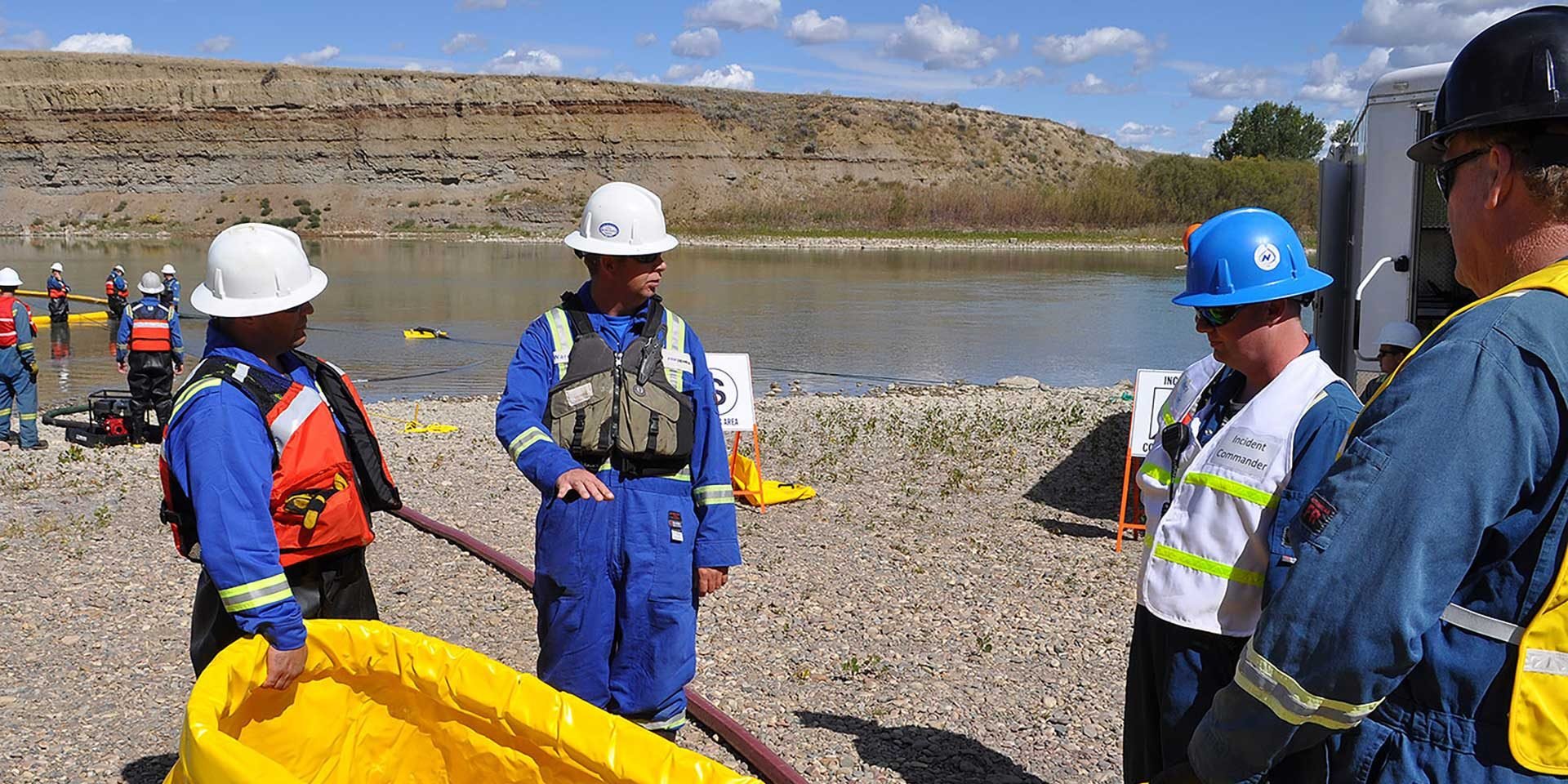Overview
Although Inter Pipeline’s goal is zero incidents, we invest heavily in training and preparedness in order to respond promptly, safely and efficiently in the unlikely event of an incident.
In 2023, 129 emergency response drills and exercises were conducted and there were zero lost time incidents recorded over approximately 6.5 million hours worked by employees and contractors. We also operate state-of-the-art control centres and leak detection systems that provide real-time operations monitoring.
Our Emergency Management Program
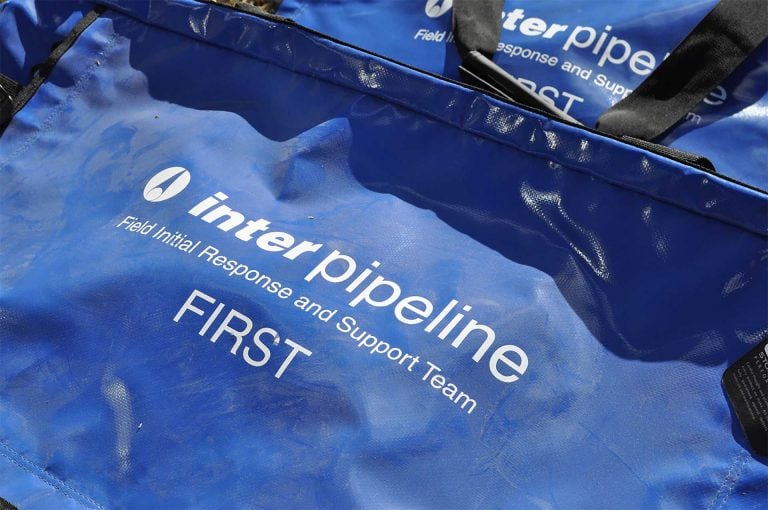
Learn more about our Emergency Management Program:
- Notification and Incident Command System
- Training and Exercises
- Emergency Response Plans
- Emergency Response Equipment
- Oil Spill Containment and Recovery (OSCAR) Trailers
- Wildlife Trailers
- Response Boats
- Safety Data Sheets (SDS)
Inter Pipeline’s Emergency Management program is an all-hazards program that includes mitigation, preparedness, response, and recovery. The program is constantly being reviewed and updated to ensure a continuous cycle of improvement.
Emergency contact and what to look for
Although rare, pipeline releases require caution and immediate action. If you notice any of the following around an Inter Pipeline facility, right-of-way, or suspect a pipeline emergency, immediately call our 24hr Emergency Number (1-800-727-7163).
Smell
- A petroleum odor (similar to gasoline or diesel fuel)
- Strong sulphur smell (like rotten eggs)
Sight
- Dead or discoloured vegetation
- Vapour or mist clouds
- Pools of liquid when the rest of the area is dry
- Petroleum sheen on water
- Dense fog-like plumes or frost balls on the ground
Sound:
- Unusual hissing or roaring sound
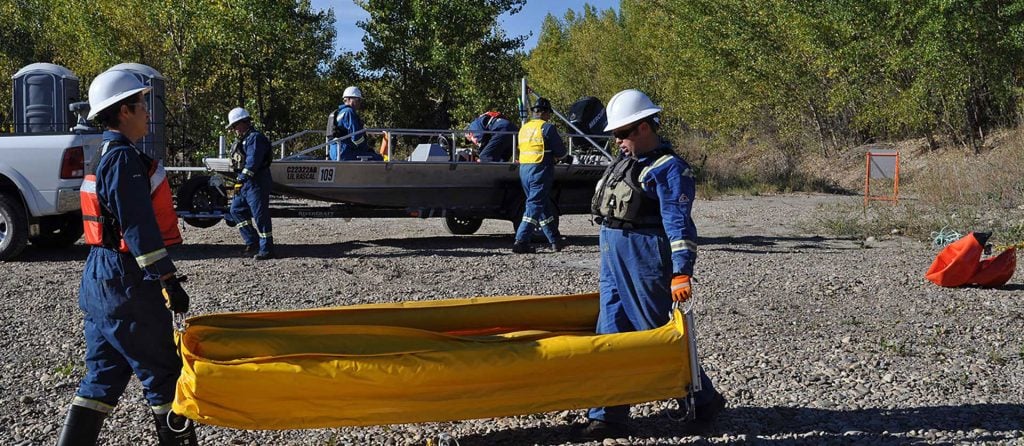
In the event of an incident, we use the Incident Command System (ICS) to effectively manage our response.
ICS is a standardized incident management system designed to enable effective, efficient incident management by integrating a combination of equipment, facilities, personnel, procedures, and communications operating within a common organizational structure. This system also facilitates effective emergency communication between Inter Pipeline personnel, emergency responders and various government agencies. ICS delineates clear roles and responsibilities, ensuring coordinated responses and effective management of emergencies by integrating functions across federal, provincial and local levels.
Our Emergency Management department maintains a database of local contacts and will contact affected communities in the event of an incident. Public notification during an emergency may occur through door-to-door visits, telephone, electronic notification, social media, broadcast media, and community signage. Notification for Indigenous communities will occur through Inter Pipeline’s Stakeholder Relations department as part of the ICS Liaison Officer responsibilities. The Stakeholder Relations department maintains a database of local Indigenous community contacts and will contact affected communities as soon as possible.
Additionally, Inter Pipeline utilizes the Alberta Energy Regulator’s (AER) Digital Data System (DDS) to provide notification to the AER of various events defined in regulations, including incidents, unauthorized activities and operations, and maintenance activities. If a member of the public wishes to report an event they can contact the Alberta Energy Regulator (AER) at 1-800-222-6514, or the Ministry of Economy in Saskatchewan at 1-844-764-3637.
Our employees receive the training necessary to protect themselves, the public, local communities, and the environment during an incident.
Training enables Inter Pipeline employees to perform their designated emergency responsibilities. Training is reinforced by conducting regular emergency response exercises and we make reasonable efforts to coordinate all training and exercise plans with key stakeholders and communities.
There are several types of emergency response training available to our employees. At a minimum, all employees who could potentially be involved in an emergency response receive Incident Command System (ICS) Level 100 training, training on emergency response plans, and operations personnel also receive spill responder training.
Response exercises allow us to practice the knowledge and skills received in training, identify areas of future training priority and areas to improve current emergency procedures or equipment, as well as engage with local response agencies. Exercises are also an opportunity to share information with first responders and stakeholders to understand each other’s roles and responsibilities in the unlikely event of an incident.
Our Field Initial Response and Support Team (FIRST) and Business Support Team and Incident Management Teams participate in exercises each year. At a minimum, each Inter Pipeline operational district participates in two exercises per year, which may be a deployment, tabletop or functional exercise. These exercises test different areas and scenarios and are held in communities where we operate.
To request participation regarding upcoming exercises, or to have your community considered as a location for an exercise, please email emergency.management@interpipeline.com and we will do our best to accommodate your request.
We are prepared to respond quickly with emergency response plans and trained professionals.
The most critical and responsible emergency preparedness strategy is to prevent an incident from occurring. We combine careful planning with regular training, equipment deployments, and mock emergency exercises. Additionally, we complete annual reviews and updates to our Emergency Response Plans (ERP) and other program documents.
Inter Pipeline’s Emergency Management Program is a comprehensive set of policies, procedures, and processes designed to support our commitment to the safety and security of the public, workers, company property, and the environment.
Our current Emergency Management Program includes Emergency Response Plans (ERP’s) that have been developed based on risk. These ERP’s are location-specific and cover all current operations for Inter Pipeline’s pipelines and facilities. The ERP’s also identify locations of emergency response materials and equipment, are regularly practiced through field deployment, and are constantly being updated to keep them current. Please see a list of ERP’s below:
Inter Pipeline Emergency Response Plan – Bow River Pipeline
Inter Pipeline Emergency Response Plan – Central Alberta Pipeline
Inter Pipeline Emergency Response Plan – Cochrane Extraction Plant
Inter Pipeline Emergency Response Plan – Cold Lake Pipeline
Inter Pipeline Emergency Response Plan – Center Function
Inter Pipeline Emergency Response Plan – Corridor Pipeline
Inter Pipeline Emergency Response Plan – Offgas Facilities
Inter Pipeline Emergency Response Plan – Mid Saskatchewan Pipeline
Inter Pipeline Emergency Response Plan – Offgas Pipelines
Inter Pipeline Emergency Response Plan – Polaris Pipeline
We also provide resident information brochures to residents that live in the vicinity of our pipelines and facilities. Please see below for brochures that have been published and distributed:
Inter Pipeline Resident Information Brochure – Bow River Pipeline (Throne)
Inter Pipeline Resident Information Brochure – Central Alberta Pipeline (Stettler)
Inter Pipeline Resident Information Brochure – Cochrane Extraction Plant (CEP)
Inter Pipeline Resident Information Brochure – Coleville Station
Inter Pipeline Resident Information Brochure – Hardisty Trim Blend Site
Inter Pipeline Resident Information Brochure – Hays Station
Inter Pipeline Resident Information Brochure – Heartland Petrochemical Complex (HPC)
Inter Pipeline Resident Information Brochure – La Corey Terminal
Inter Pipeline Resident Information Brochure – Mid Sask Pipeline (Dodsland)
Inter Pipeline Resident Information Brochure – Mid Sask Pipeline (Kerrobert)
Inter Pipeline Resident Information Brochure – Milk River
Inter Pipeline Resident Information Brochure – Offgas Pipelines (Boreal, Horizon, Olefins)
Inter Pipeline Resident Information Brochure – Pioneer 1 and 2 Offgas Extraction Facilities
Inter Pipeline Resident Information Brochure – Tilley Station
We own and maintain a large cache of emergency response equipment strategically placed in Alberta and Saskatchewan. This equipment ensures we are able to respond to any emergency in a timely manner.
Inter Pipeline is proud to be a member in good standing with Western Canadian Spill Services (WCSS).
Emergency response equipment, such as spill drums with absorbent material to assist in immediate cleanup of any local spills, is available at all facilities. Other emergency resources, such as riverboats and response trailers, are located at strategic locations in each operational district and can be mobilized as required.
OSCAR trailers are located strategically in each of our operational districts. These trailers contain various tools and spill response equipment ranging from absorbent materials and skimmers to booms and other cleanup tools specific to the area.
Inter Pipeline has a comprehensive Wildlife Emergency Response Program employing a multi-faceted approach; from specialized equipment to plans, hands-on testing/training, and GIS.
We have multiple levels of wildlife equipment strategically placed and stored along with our assets that range from basic to advanced. There are basic kits located at each of our district offices that can be quickly deployed to provide an initial level of deterrent to wildlife in the area. Larger trailers are stationed in strategic locations that carry an array of additional and specialized deterrents, traps, and fencing to prevent wildlife from entering a release location. Specialized equipment within the trailers would be installed to meet site-specific conditions. Some equipment can be deployed immediately and other techniques take more time and incredible labour and effort. Therefore, equipment is deployed in a systematic manner to ensure the most effective and efficient deployment to successfully deter targeted species.
To quickly assess the site for potential wildlife conflicts that will inform our equipment deployment strategy, Inter Pipeline has a GIS system with multiple environmental layers providing wildlife, wetland, water, vegetation, and other potential conflicts. We are also equipped with a Wildlife Emergency Response Plan and a program that works to continually expand on wildlife response capabilities.
Inter Pipeline owns and maintains a number of boats that range in size from 18’ to 24’. The boats are located in various operational areas to ensure response actions can be carried out in the areas where a spill could potentially impact water bodies.

We ensure emergency personnel responding to an incident have access to accurate product information.
Safety Data Sheets (SDS) provide workers and emergency responders with information on handling or working with controlled substances in a safe manner.
This includes information such as physical data, toxicity, health effects, first aid, reactivity, storage, disposal, protective equipment, and spill-handling procedures.
More
In 'Sustainability'

Indigenous Relations

Environment
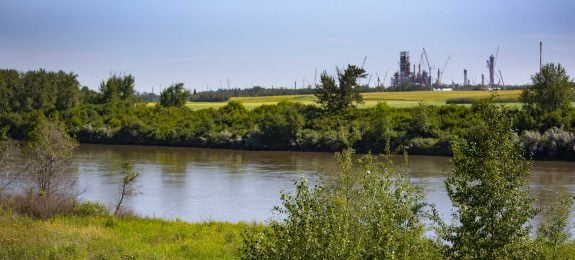
ESG Reporting
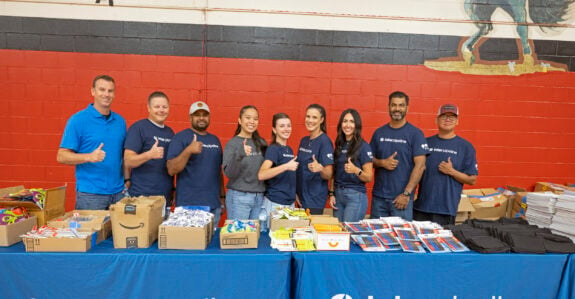
Community Initiatives
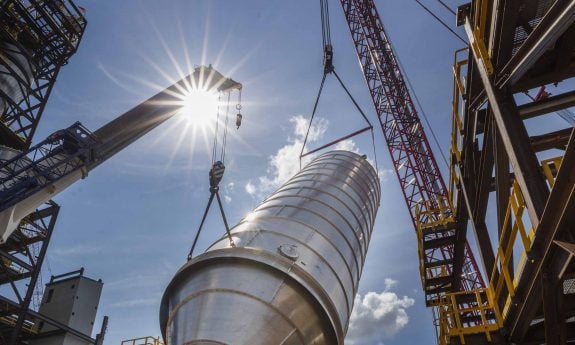
Governance

Landowners
